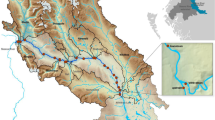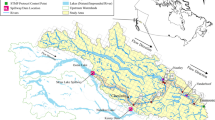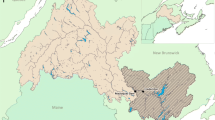Abstract
This study evaluates the sensitivity of Washington State’s freshwater habitat of Pacific Salmon (Oncorhynchus spp.) to climate change. Our analysis focuses on summertime stream temperatures, seasonal low flows, and changes in peak and base flows because these physical factors are likely to be key pressure points for many of Washington’s salmon populations. Weekly summertime water temperatures and extreme daily high and low streamflows are evaluated under multimodel composites for A1B and B1 greenhouse gas emissions scenarios. Simulations predict rising water temperatures will thermally stress salmon throughout Washington’s watersheds, becoming increasingly severe later in the twenty-first century. Streamflow simulations predict that basins strongly influenced by transient runoff (a mix of direct runoff from cool-season rainfall and springtime snowmelt) are most sensitive to climate change. By the 2080s, hydrologic simulations predict a complete loss of Washington’s snowmelt dominant basins, and only about ten transient basins remaining in the north Cascades. Historically transient runoff watersheds will shift towards rainfall dominant behavior, undergoing more severe summer low flow periods and more frequent days with intense winter flooding. While cool-season stream temperature changes and impacts on salmon are not assessed in this study, it is possible that climate-induced warming in winter and spring will benefit parts of the freshwater life-cycle of some salmon populations enough to increase their reproductive success (or overall fitness). However, the combined effects of warming summertime stream temperatures and altered streamflows will likely reduce the reproductive success for many Washington salmon populations, with impacts varying for different life history-types and watershed-types. Diminishing streamflows and higher stream temperatures in summer will be stressful for stream-type salmon populations that have freshwater rearing periods in summer. Increased winter flooding in transient runoff watersheds will likely reduce the egg-to-fry survival rates for ocean-type and stream-type salmon.
Similar content being viewed by others
References
Battin J, Wiley MW, Ruckelshaus MH, Palmer RN, Bartz KK, Imaki H, Korb E (2007) Projected impacts of climate change on salmon habitat restoration. Proc Natl Acad Sci U S A 104:6720–6725
Beamer EM, Pess GR (1999) Effects of peak flows on chinook (Oncorhynchus tshawytscha) spawning success in two Puget Sound river basins. In: Sakrison R, Sturtevant P (eds) Watershed management to protect declining species. Am Water Resour Assoc, Middleburg, pp 67–70
Beechie TJ, Beamer EM, Wasserman L (1994) Estimating coho salmon rearing habitat and smolt production losses in a large river basin, and implications for habitat restoration. N Am J Fish Manag 14:797–811
Beechie TJ, Ruckelshaus M, Buhle E, Fullerton A, Holsinger L (2006) Hydrologic regime and the conservation of salmon life history diversity. Biol Conserv 130:560–572
Beechie TJ, Moir H, Pess G (2008a) Hierarchical physical controls on salmonid spawning location and timing. In: Sear D, DeVries P (eds) Salmonid spawning habitat in rivers: physical controls, biological responses, and approaches to remediation. Am Fish Soc, Symposium 65, Bethesda, pp 83–102
Beechie T, Pess G, Roni P, Giannico G (2008b) Setting river restoration priorities: a review of approaches and a general protocol for identifying and prioritizing actions. North Am J Fish Manage 28(3):891–905
Booth DB, Jackson CJ (1997) Urbanization of aquatic systems—degradation thresholds, stormwater detention, and the limits of mitigation. Water Resour Bull 33:1077–1090
Crozier LG, Zabel RW (2006) Climate impacts at multiple scales: evidence for differential population responses in juvenile chinook salmon. J Anim Ecol 75:1100–1109
Crozier LG, Zabel RW, Hamlet A (2008a) Predicting differential effects of climate change at the population level with life-cycle models of spring chinook salmon. Glob Chang Biol 14:236–249
Crozier LG, Lawson PW, Quinn TP, Hendry AP, Battin J, Mantua NJ, Eldridge W, Shaw RG (2008b) Evolutionary responses to climate change for organisms with complex life histories: Columbia River salmon as a case in point. Evol Appl 1(1):252–270
DeVries PE (1997) Riverine salmonid egg burial depths: review of published data and implications for scour studies. Can J Fish Aquat Sci 54:1685–1698
Eaton JG, Scheller RM (1996) Effects of climate warming on fish thermal habitat in streams of the United States. Limnol Oceanogr 4l:109–1115
Elsner MM, Cuo L, Voisin N, Deems JS, Hamlet AF, Vano JA, Mickelson KEB, Lee SY, Lettenmaier DP (2010) Implications of 21st century climate change for the hydrology of Washington State. Clim Change. doi:10.1007/s10584-010-9855-0
Environmental Protection Agency (2007) Biological evaluation of the revised Washington water quality standards. US EPA, Seattle
Fabry VJ, Seibel BA, Feely RA, Orr JC (2008) Impacts of ocean acidification on marine fauna and ecosystem processes. ICES J Mar Sci 65:414–432
Farrell AP, Hinch SG, Cooke SJ, Patterson DA, Crossin GT, Lapointe M, Mathes MT (2008) Pacific salmon in hot water: applying aerobic scope models and biotelemetry to predict the success of spawning migrations. Physiol Biochem Zool 81(6):697–708
Goniea TM, Keefer ML, Bjornn TC, Peery CA, Bennett DH (2006) Behavioral thermoregulation and slowed migration by adult fall chinook salmon in response to high Columbia River water temperatures. Trans of the Am Fish Soc 135:408–419. doi:10.1577/T04-113.1
Greene CM, Jensen DW, Beamer E, Pess GR, Steel EA (2005) Effects of environmental conditions during stream, estuary, and ocean residency on chinook salmon return rates in the Skagit River, WA. Trans of the Am Fish Soc 134:1562–1581
Healey MC (1991) In: Groot C, Margolis L (eds) Pacific Salmon Life Histories. Univ British Columbia Press, Vancouver, Canada, pp 313–393
High B, Perry CA, Bennett DH (2006) Temporary staging of Columbia River summer steelhead in cool-water areas and its effect on migration rates. Trans Am Fish Soc 135:519–528
Hodgson S, Quinn TP (2002) The timing of adult sockeye salmon migration into fresh water: adaptations by populations to prevailing thermal regimes. Can J Zool 80:542–555
Holtby LB (1988) Effects of logging on stream temperatures in Carnation Creek, British Columbia, and associated impacts on the coho salmon (Oncorhynchus kisutch). Can J Fish Aquat Sci 45:502–515
Holtby LB, Healey MC (1986) Selection for adult size in female coho salmon (Oncorhynchus kisutch). Can J Fish Aquat Sci 43:1946–1959
Hosking JRM (1990) L-moments: analysis and estimation of distributions using linear combinations of order statistics. J R Stat Soc Ser B 52:105–124
Hosking JRM, Wallis JR (1993) Some statistics useful in regional frequency analysis. Water Resour Res 29(2):271–281
Independent Multidisciplinary Science Team (IMST) (2000) Influences of human activity on stream temperatures and existence of cold-water fish in streams with elevated temperature: report of a workshop. Tech. Rep. 2000-2 to the Oregon Plan for Salmon and Watersheds. Oregon Watershed Enhancement Board. Salem, Oregon
Independent Scientific Advisory Board (ISAB) (2007) Climate change impacts on Columbia River Basin fish and wildlife. ISAB Climate Chang Rep. http://www.nwcouncil.org/library/isab/isab2007–2.htm)
Latterell JJ, Fausch KD, Gowan C, Riley SC (1998) Relationship of trout recruitment to snowmelt runoff flows and adult trout abundance in six Colorado mountain streams. Rivers 6:240–250
Logerwell EA, Mantua NJ, Lawson P, Francis RC, Agostini V (2003) Tracking environmental processes in the coastal zone for understanding and predicting Oregon coho (Oncorhynchus kisutch) marine survival. Fisheries Oceanogr 12(6):554–568
Lotspeich FB, Everest FH (1981) A new method for reporting and interpreting textural composition of spawning gravel. US Forest Service Research Note PNW-369
Martin J (2006) Climate and development: salmon caught in the squeeze. In: Lackey R, Lach D, Duncan S (eds) Salmon 2100: the future of wild pacific salmon. Am Fish Soc, 629 pp
McCullough DA (1999) A review and synthesis of effects of alterations to the water temperature regime on freshwater life stages of salmonids, with special reference to chinook salmon. Water Resour Assess, US EPA 910-R-99-010, 291 pp, Seattle
Miles EL, Snover AK, Hamlet AF, Callahan BM, Fluharty DL (1999) Pacific Northwest regional assessment: the impacts of climate variability and climate change on the water resources of the Columbia River Basin. Prepared for the Am Water Resour Assoc Specialty Conf on the Potential Consequences of Clim Variability and Chang to Water Resour of the US, Atlanta
Mohseni OS, Stefan HG, Erickson TR (1998) A nonlinear regression model for weekly stream temperatures. Water Resour Res 34:2685–2692
Montgomery DR, Buffington JM, Peterson NP, Schuett Hames D, Quinn TP (1996) Streambed scour, egg burial depths, and the influence of salmonid spawning on bed surface mobility and embryo survival. Can J Fish Aquat Sci 53:1061–1070
Moore RD and Wondzell SM (2005) Physical hydrology and the effects of forest harvesting in the Pacific Northwest: a review. J Am Water Resour Assoc 41:753–784
Mote PW, Salathé EP Jr (2010) Future climate in the Pacific Northwest. Clim Change. doi:10.1007/s10584-010-9848-z
Nash JE, Sutcliffe JV (1970) River flow forecasting through conceptual models. J Hydro 10:282–290
Naughton GP, Caudill CC, Keefer ML, Bjornn TC, Stuehrenberg LC, Peery CA (2005) Late-season mortality during migration of radio-tagged sockeye salmon (Oncorhynchus nerka) in the Columbia River. Can J Fish Aquat Sci 62:30–47
Newell JA, Fresh KL, Quinn TA (2007) Arrival patterns and movements of adult sockeye salmon (Oncorhynchus) in Lake Washington: implications for management of an urban fishery. North Am J Fish Manage 27(3):908–917
O’Neal K (2002) Effects of global warming on trout and salmon in U.S. streams. Defenders of Wildlife, Washington, 46 pp
Pearcy WM (1992) Ocean ecology of North Pacific salmonids. Washington Sea Grant, Seattle, 179 pp
Rand PS, Hinch SG, Morrison J, Foreman MGG, MacNutt MJ, Macdonald JS, Healey MC, Farrell AP, Higgs DA (2006) Effects of river discharge, temperature, and future climates on energetics and mortality of adult migrating Fraser River sockeye salmon. Trans Am Fish Soc 135:655–667
Reeves GH, Everest FH, Nickelson TE (1989) Identification of physical habitats limiting the production of Coho salmon in western Oregon and Washington. Technical Report PNW-GTR-245, US Dep of Agric, For Service, Pacific Northwest Res Sn, Portland, OR
Richter A, Kolmes SA (2005) Maximum temperature limits for chinook, coho, and chum salmon, and steelhead trout in the pacific northwest. Rev in Fish Sci 13(1):23–49. doi:10.1080/10641260590885861
Salathé EP Jr, Leung LR, Qian Y, Zhang Y (2010) Regional climate model projections for the State of Washington. Clim Change. doi:10.1007/s10584-010-9849-y
Schindler DE, Rogers LA (2009) Responses of salmon populations to climate variations in freshwater ecosystems. In: Krueger CC, Zimmerman CE (eds) Pacific salmon: ecology and management of western Alaska’s populations. American Fisheries Society, Symposium 70, Bethesda, pp 1127–1142
Seiler D, Neuhauser S, Kishimoto L (2003) 2002 Skagit River wild 01 chinook production evaluation annual report. Washington Department of Fish and Wildlife, Olympia
SRES (Special Report on Emissions Scenarios) (2000) Nakicenovic, Nebojsa and Swart, Rob (eds), Cambridge University Press, Cambridge, United Kingdom, 612 pages. Intergovernmental Panel on Climate Change Special Report on Emissions Scenarios
Tabor RA, Celedonia MT, Mejia F, Piaskowski RM, Low DL, Footen B, Park L (2004) Predation of juvenile chinook salmon by predatory fishes in three areas of the Lake Washington basin. US Fish and Wildlife Service, Western Washington Fish and Wildlife Office, Lacey
Wang QJ (1997) LH moments for statistical analysis of extreme events. Water Resour Res 33(12):2841–2848
Waples RS, Pess GR, Beechie T (2008) Evolutionary history of pacific salmon in dynamic environments. Evol Appl 1(2):189–206. doi:10.1111/j.1752-4571.2008.00023.x
Author information
Authors and Affiliations
Corresponding author
Rights and permissions
About this article
Cite this article
Mantua, N., Tohver, I. & Hamlet, A. Climate change impacts on streamflow extremes and summertime stream temperature and their possible consequences for freshwater salmon habitat in Washington State. Climatic Change 102, 187–223 (2010). https://doi.org/10.1007/s10584-010-9845-2
Received:
Accepted:
Published:
Issue Date:
DOI: https://doi.org/10.1007/s10584-010-9845-2




